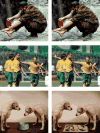Eye movements when looking at unusual/weird scenes: are there cultural differences?
- PMID: 19210095
- PMCID: PMC2668126
- DOI: 10.1037/a0013508
Eye movements when looking at unusual/weird scenes: are there cultural differences?
Abstract
Recent studies have suggested that eye movement patterns while viewing scenes differ for people from different cultural backgrounds and that these differences in how scenes are viewed are due to differences in the prioritization of information (background or foreground). The current study examined whether there are cultural differences in how quickly eye movements are drawn to highly unusual aspects of a scene. American and Chinese viewers examined photographic scenes while performing a preference rating task. For each scene, participants were presented with either a normal or an unusual/weird version. Even though there were differences between the normal and weird versions of the scenes, there was no evidence of any cultural differences while viewing either scene type. The present study, along with other recent reports, raises doubts about the notion that cultural differences can influence oculomotor control in scene perception.
Figures
References
-
- Becker MW, Pashler H, Lubin J. Object-intrinsic oddities draw early saccades. Journal of Experimental Psychology: Human Perception and Performance. 2007;33:20–30. - PubMed
-
- Boland JE, Chua HF, Nisbett RE. How we see it: Culturally different eye movement patterns over visual scenes. In: Rayner K, Shen D, Bai X, Yan G, editors. Cognitive and cultural influences on eye movements. Tianjin, China: Tianjin People’s Press/Psychology Press; 2008. pp. 363–378.
-
- Brockmole JR, Henderson JM. Prioritizing new objects for eye fixation in real-world scenes: Effects of object-scene consistency. Visual Cognition. 2008;16:375–390.
-
- Calvo MG, Lang PJ. Parafoveal semantic processing of emotional visual scenes. Journal of Experimental Psychology: Human Perception and Performance. 2005;31:502–519. - PubMed
-
- Calvo MG, Nummenmaa L. Processing of unattended emotional visual scenes. Journal of Experimental Psychology: General. 2007;136:347–369. - PubMed


